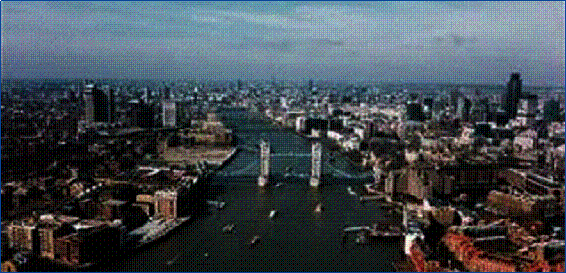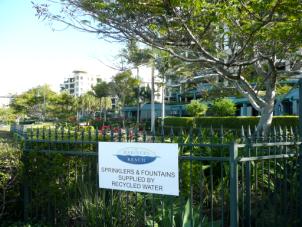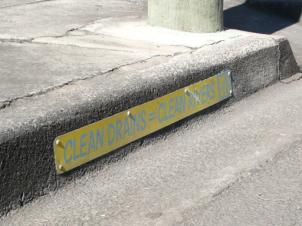
WASTEWATER RESEARCH AND INDUSTRY SUPPORT FORUM
Meeting 2nd July 2008
Please note that for older reports some links will be to sites that are no longer active.
This was the Forum’s 36th meeting. The theme of the meeting was innovation in the water industry.
Siān Hills, Thames Water’s Sustainable Resources & Customer Research Manager, reviewed her experience of innovations in water recycling and reuse. Ensuring London’s water supply is a challenge, the Thames Basin, which could be described as a “cloudy desert”, is one of most heavily used systems in the world, 55% of effective rainfall utilised already (the next most is intensive in the UK is Anglian Water at only 25%) and customer demand for water is predicted to increase by 20% by 2030. In this context it is understandable that Thames Water has studied how to make best use of its scarce resource.

The Millennium Dome in London was a good opportunity to evaluate a range of aspects. Thames built and operated a 500m3/d recycling plant comparing reedbeds, biological aerated filter and membranes; it also evaluated the water efficiency of washroom appliances and used it as a facility to educate members of the public and research attitudes. Overall only 45% of the water used in the Dome was taken from potable supplies with the remainder being reclaimed. However, using reclaimed water means that there must be separate pipework systems (reticulation) for potable and reclaimed. Harvesting water from the large roof was an obvious idea but since rainfall is intermittent it entails storage, which is expensive. Roofs also collect contamination from bird droppings and atmospheric deposition so the water must be treated. Rainwater accounted for 19%, greywater 10% and groundwater 71% of the non-potable water. The groundwater was brackish so needed treatment.
The benefits of water saving appliances were measured in a “Super efficient core”. These comprised dual flush toilets, waterless urinals and infrared taps, which were all quite new technology in 1999/2000. Water use was compared with “Control cores” (standard appliances) comprising siphonic flush toilets, flushing urinals, swivel-top taps and push-top taps. 150 meters were installed to measure water use. Initially the “water efficient” appliances used more water than the conventional because of malfunctions and poor design: for dual flush toilets to be effective, it is not jut a matter of reducing the volume of the flushes, the whole WC must be redesigned was well. Eventually the water consumption of the “water efficient” appliances (except for the infrared taps) was very slightly better than the conventional ones. This demonstrated that members of the public were quite water-aware and turned off the swivel-top taps when they had finished with them. Manufacturers have improved their water-efficient appliances since 2000 and it would be interesting to re-run a comparison such as that undertaken at the Dome to measure how efficient they are really.
Visitor’s acceptance of reclaimed water was related to the intended use in the order toilet flushing > car washing > window washing > watering ornamentals > watering food plants. However, 61% of visitors would accept watering food plants with reclaimed water. When visitors received information about the ‘science’ of water reclamation, their acceptance increased.
Water is working with BedZED (Beddington Zero Energy Development) to improve the performance of its water recycling and reclamation. The system was designed to use reclaimed wastewater and harvested rainwater for toilet flushing and garden irrigation. The aim was to decrease demand for potable supplies and sewerage capacity, with resulting savings in both water resources and energy. It has proved less successful than expected. Thames has been able to bring some of the knowledge from when it owned Applied Water Management Inc. in USA. One of the key aspects from this and other experience is the importance of maintenance. In a trial development in a development of executive homes in UK, the owners claimed to be very happy with their water reclamation installations, but on examination it was found that because of lack of maintenance they were not working and the systems were drawing “top-up” water from the potable supply. Water reclamation is not “fit and forget”.
World-wide there are many water reclamation/reuse initiatives. Reuse for industrial purposes is more straight forward than domestic. Dual reticulation has many complications for water providers e.g. water quality, regulations, inspecting for misconnections. The technology is OK but the economics are questionable.
We have been doing unplanned Indirect Potable Reuse (IPR) for decades. Treated wastewater from a community at the top of a catchment is discharged to a river and further down the river water is abstracted, treated and put into potable supply. This is illustrated in many texts as part of the water cycle. It is said popularly that the water in the Thames is drunk seven times between the source and the sea. There is no, or at best very questionable, evidence that this indirect potable use has had adverse effects on humans. Modern analytical techniques are so sensitive that various anthropogenic chemicals can be measured in water but concentrations are such that the doses delivered are less than the adverse effects thresholds. However proposals for planned IPR have met fierce opposition in some countries; the arguments might not have been rational but they were certainly very emotional. Development of guidelines for acceptable standards for planned IPR has led to a “tyranny of numbers” whereby there is a tendency for new guidelines to add precaution to [already safe] predecessors. It could be that advanced water treatment will be needed in future just to achieve the IPR that we have been doing for decades. The financial and carbon costs would be substantial if this were to happen.
Thames Water has built a 600 m3/d pilot plant at Deephams WwTW, Edmonton, N. London comprising dosing of chloramine at three locations, 0.5mm screens, microfiltration, reverse osmosis, advanced oxidation with UV, hydrogen peroxide and activated carbon. During 2 years’ operation it will evaluate the cost and effectiveness. If this level of treatment proves necessary, the first 25,000 m3/d plant could be operational in 2016/2020.
Fiona Griffith from Mouchel described TAG (Technology Approvals Group) which is the product of a strategic partnership between Foresight Group, a leading investor in unquoted companies, and Mouchel to invest in ‘cleantech’ infrastructure projects in the UK. TAG has received support from ETV-LIFE. It reduces the risk of trying new technologies. Currently, there are 11 water companies in the water TAG, which meets 4 times per year. TAG searches out promising technologies and their providers are given the opportunity to make a 20 minute presentation after which the water company representatives debate their reactions and the possible virtues of the technology. Mouchel has a team of 4 people on the water TAG; they have seen 600 technologies and reviewed 480 of them. Because of Mouchel’s diligence, only 6 of the 55 technologies presented to the TAG Panel Meetings have been rejected.
TAG helps technology providers by testing their proposition against TAG’s understanding of the needs of technology users. If a technology is unlikely to find a market it is valuable for its inventor to know that before wasting too much time and money. Alternatively TAG might be able to advise how the proposition could be improved. Equally, if TAG considers a technology has potential, it provides a “marriage broker” service with users and investors.
For potential investors, TAG provides market and technology intelligence; is there a market for this technology? How large is the market? Is the pricing appropriate? How much competition is there and how easy will it be to gain market share?
For potential users of the technology, TAG provides intelligence of new technologies that might be useful to their businesses.
Tim Evans (Technical Secretary to the Forum and independent consultant) described some of the innovations / interesting features seen during a recent visit to Perth, Adelaide, Sydney, Melbourne and Brisbane in Australia. In many places municipal administrations have been merged, which has enabled more regional solutions, shared by administrations. This is the strategy we are used to in the UK water industry because regional water operators were created more than 30 years ago, but has not been true in some other countries where administrations guard their fiefdoms jealously.
Stuart McAll, manager of the Southern Metropolitan Regional Council’s solid waste recovery centre in Perth said “the first thing we did was behavioural analysis research, then we designed a system to fit the behaviour”. This is really smart and the converse of the conventional approach, which is to design a system and then “educate” the public to use it.
 At Christie Beach WwTW in Adelaide there is a reservoir, pumping station and pipeline that had been funded by farmers who saw that treated water was being discharged to the ocean, and realised that they could use this water to irrigate their vines. An interesting feature of this innovation is that it reduces the cost of wastewater treatment. This, and another works, between them spend $1 million per year on molasses to feed the BNR plants (biological nutrient removal) to avoid damaging sea grass, but when the water is used for irrigation, the nutrients are valuable replacements for mineral fertilisers. There must be some financial balance between the Capex and Opex of supplying fertigation water (offset by income from selling the water) and the saving not having to import carbon to feed BNR. Without irrigation water, many Australian farms would have no value.
At Christie Beach WwTW in Adelaide there is a reservoir, pumping station and pipeline that had been funded by farmers who saw that treated water was being discharged to the ocean, and realised that they could use this water to irrigate their vines. An interesting feature of this innovation is that it reduces the cost of wastewater treatment. This, and another works, between them spend $1 million per year on molasses to feed the BNR plants (biological nutrient removal) to avoid damaging sea grass, but when the water is used for irrigation, the nutrients are valuable replacements for mineral fertilisers. There must be some financial balance between the Capex and Opex of supplying fertigation water (offset by income from selling the water) and the saving not having to import carbon to feed BNR. Without irrigation water, many Australian farms would have no value.
 After 8 years of drought in some parts of Australia and the dire state of the Murray-Darling river system, members of the public are very water-aware. The resource level is a topic of daily conversation, as the weather is in the UK. Signs saying that gardens and landscaping have been irrigated with reclaimed water are commonplace. Even in small country towns there are water awareness messages by drains.
After 8 years of drought in some parts of Australia and the dire state of the Murray-Darling river system, members of the public are very water-aware. The resource level is a topic of daily conversation, as the weather is in the UK. Signs saying that gardens and landscaping have been irrigated with reclaimed water are commonplace. Even in small country towns there are water awareness messages by drains.